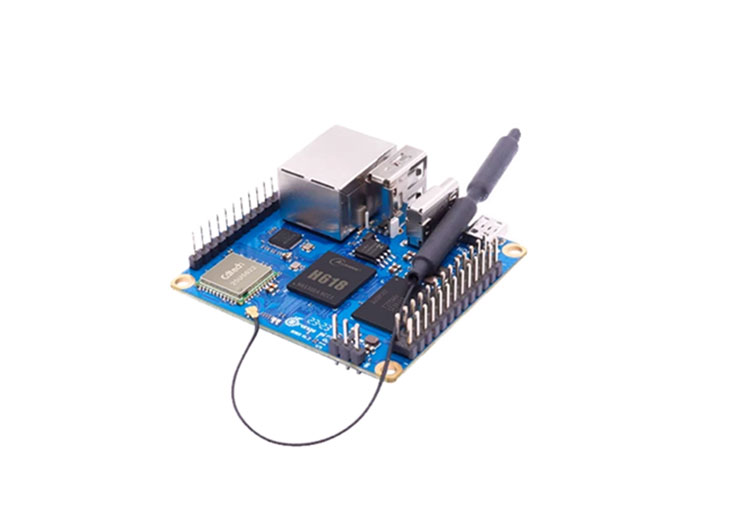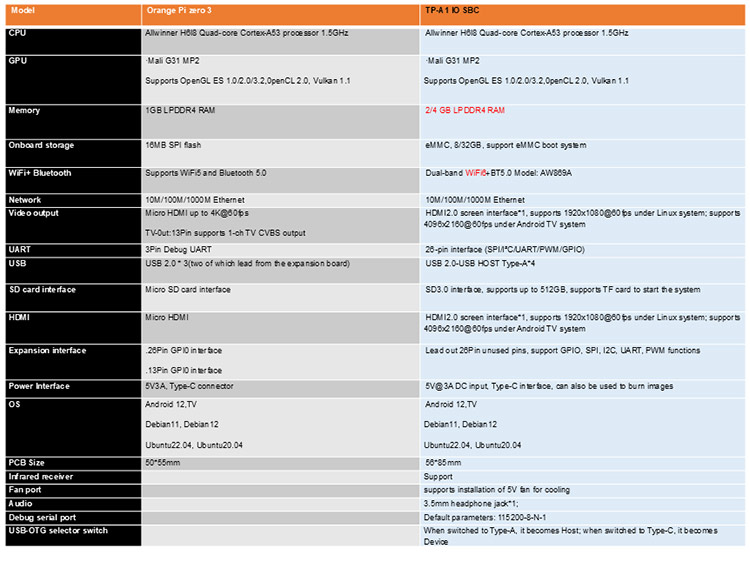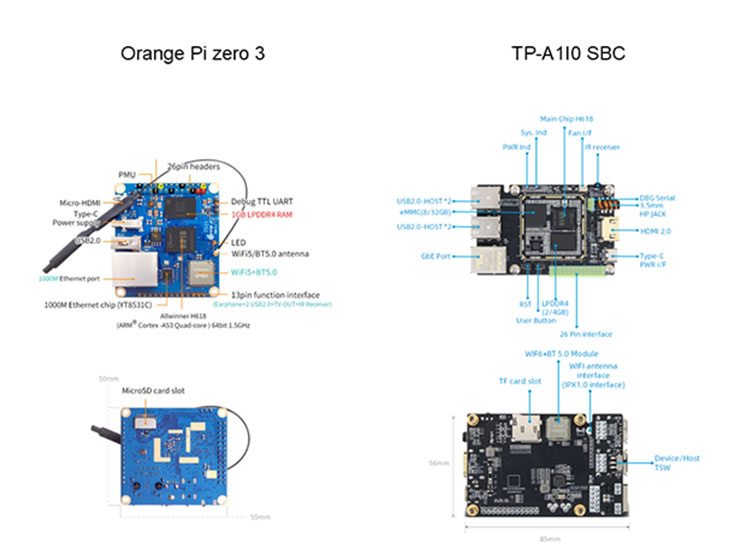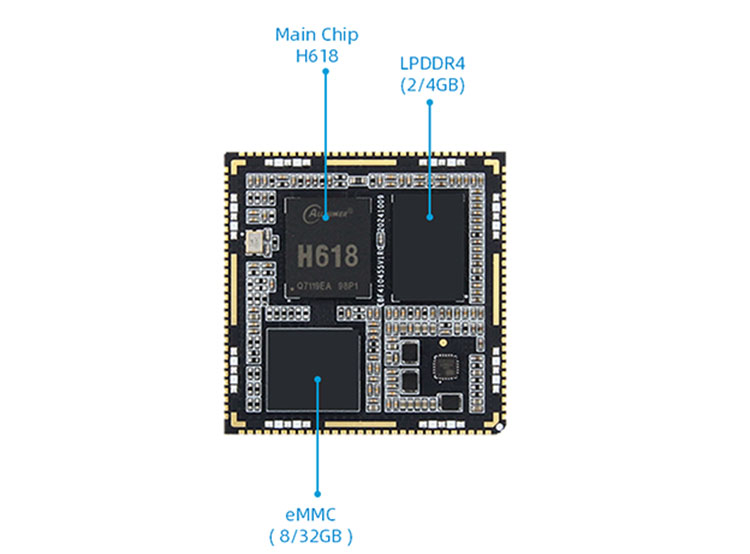
- English
- Español
- Português
- русский
- Français
- 日本語
- Deutsch
- tiếng Việt
- Italiano
- Nederlands
- ภาษาไทย
- Polski
- 한국어
- Svenska
- magyar
- Malay
- বাংলা ভাষার
- Dansk
- Suomi
- हिन्दी
- Pilipino
- Türkçe
- Gaeilge
- العربية
- Indonesia
- Norsk
- تمل
- český
- ελληνικά
- український
- Javanese
- فارسی
- தமிழ்
- తెలుగు
- नेपाली
- Burmese
- български
- ລາວ
- Latine
- Қазақша
- Euskal
- Azərbaycan
- Slovenský jazyk
- Македонски
- Lietuvos
- Eesti Keel
- Română
- Slovenski
- मराठी
- Srpski језик
Orange Pi Zero 3 vs. Thinkcore TP-A0 H618 SBC. Which SBC is Right for You?
2025-09-10
As a representative of Orange Pi's classic quality, Orange Pi Zero 3 continues the Zero series' strong performance, compact appearance, and high cost-effectiveness. It is equipped with a more powerful processor, the Allwinner H618, and larger and more optional memory, providing users with a better user experience and is highly favored by users.

Orange Pi Zero 3 is widely liked in the market for its ultimate cost-effectiveness.
The following chart shows the interface display of Orange Pi Zero 3.
| Model | Orange Pi Zero 3 |
| CPU | Allwinner H6l8 Quad-core Cortex-A53 processor 1.5GHz |
| GPU | ·Mali G31 MP2Supports OpenGL ES 1.0/2.0/3.2, 0penCL 2.0, Vulkan 1.1 |
| Memory | 1GB LPDDR4 RAM |
| Onboard storage | 16MB SPl flash |
| WiFi+ Bluetooth | Supports WiFi5 and Bluetooth 5.0 |
| Network | 10M/100M/1000M Ethernet |
| Video output | Micro HDMl up to 4K@60fpsTV-0ut:13Pin supports 1-ch TV CVBS output |
| UART | 3Pin Debug UART |
| USB | USB 2.0 * 3(two of which lead from the expansion board) |
| SD card interface | Micro SD card interface |
| HDMI | Micro HDMI |
| Expansion interface | .26Pin GPl0 interface.13Pin GPl0 interface |
| Power Interface | 5V3A, Type-C connector |
| OS | Android 12, TVDebian11, Debian12Ubuntu22.04, Ubuntu20.04 |
| PCB Size | 50*55mm |
As you can see, the Orange Pi 3 Parameters interface is very compact. This is because the Orange Pi Zero 3 is positioned for users with extremely limited budgets who need a compact size and whose project requirements match its features, such as: a lightweight Docker container host (running Home Assistant, etc.) and an entry board for learning Linux and embedded development.
In this case, in order to make up for the shortcomings of Orange Pi zero3, we developed our own TP-A1I0 H618 SBC for customers who need a motherboard with better scalability and stability? For users who are familiar with single-board computers like the Orange Pi Zero 3, the TP-A1 I0 H618 sbc offers a more feature-rich experience
Below is a table comparing our TP-A1 I0 H618 SBC and Orange Pi 3 interfaces.


As can be seen from the table above, the Orange Pi zero3 has the following shortcomings:
1. Limited USB Port Performance and Number
The Orange Pi 3 has only one USB 2.0 port and one USB Type-C port, which are only used for power delivery, making the board's expandability poor. This prevents customers from connecting multiple USB devices (such as keyboards, mice, and USB flash drives). If necessary, an external USB hub must be used, adding additional cost and complexity.
Our board has 4 USB HOST Type-A interfaces, which can meet most needs.
2. The insufficient speed of the Gigabit Ethernet port.
The Orange Pi zero 3 Gigabit Ethernet port is not an independent channel, but shares a bus bandwidth with the USB 2.0 port. This means that when the USB port is transmitting data, the network speed will be affected and reduced, and the performance of the Gigabit Ethernet port cannot be fully utilized.
Our board has an independent Gigabit Ethernet port. The actual data transmission rate of the ETH0 wired Ethernet interface at the current moment is TX:700Mbps/ RX:900Mbps(This data is tested using iperf3 software. The rate is the TCP communication rate, which is less than the physical link bandwidth)
3. Lack of on-board eMMC
The Orange Pi 3 lacks an onboard eMMC storage option; the system must boot and run from a microSD card. Even with a high-speed SD card, the read and write speeds are much lower than those of an eMMC or SSD. This results in slow system boots and slow application loading.
Our board has 8GB/32GB eMMC onboard, which is plug-and-play and runs faster and more stably. It is more suitable for finished equipment and industrial scenarios.
4.No earphones or infrared port
13Pin functional interface integrates headphone + 2 USB2.0 + TV-0ut + infrared.
Our board has brought out and soldered a 3.5mm headphone jack and an infrared receiver.
5.Not friendly enough for newbies.
As mentioned above, this board does not have an onboard eMMC, so owners need to burn the relevant image from the TF card and then insert it into the motherboard and perform a series of operations to start the motherboard and run the system normally. For inexperienced novices, these operations may be difficult and prone to errors.
Our board is configured with different eMMC memory!
Summary: Which projects are not suitable for the Orange Pi Zero 3?
Based on the above shortcomings, it's not suitable for the following scenarios:
• Home NAS servers: SD card storage is a fatal flaw.
• Projects requiring multiple USB ports
• Applications with extremely high network performance requirements: such as a main router that needs to run at full gigabit bandwidth.
• Those seeking an absolutely stable, out-of-the-box operating environment: due to the relative instability of SD cards and software.
• Complete software development novices: may encounter frustration with software configuration.
Thus, if you have the following requirements, our H618 SBC may be a better choice.
- For creating a Home Assistant NAS or a soft router, our TP A1I0 H618 SBC is more advantageous!
The Orange Pi Zero 3 has two USB 2.0 ports, while the TP-A1I0 offers four, allowing for more external storage expansion.
- For applications requiring extremely high network performance, such as soft routers, our Gigabit Ethernet port is faster!
- Our board features a built-in eMMC slot, ensuring more stable and faster system operation, while the Orange Pi requires booting from a TF card..."
- We've optimized the heat dissipation design, allowing the board to support a 5V fan.
Conclusion: If you're looking for ultimate value, choose the Orange Pi; if you need greater scalability and stability, our product is a better choice."
In addition, our core boards can be purchased separately, facilitating rapid R&D and accelerating product launch.

Contact us for more information and samples!



